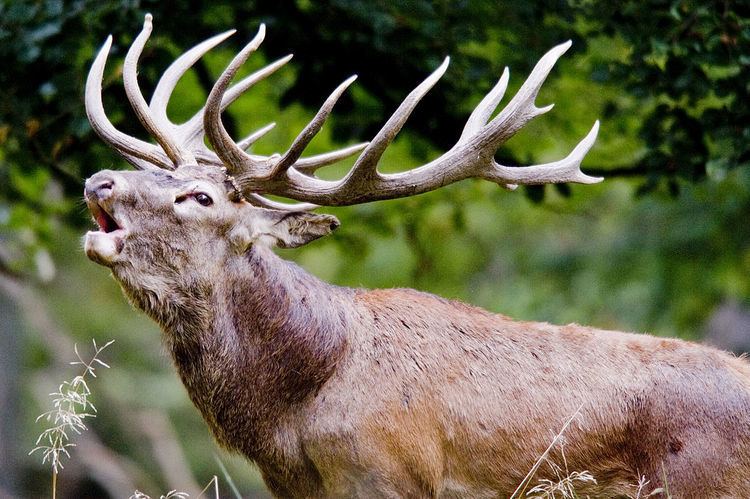 | ||
A roar is a type of animal vocalization consisting of both a low fundamental frequency (pitch) and low formant frequency. Mammals of various species have evolved to produce roars and roar-like vocalizations for long-distance communication and territorial or mate defense. These include the big cats, red deer, various bovids, some pinnipeds, bears, howler monkeys, hammer-headed bats, elephants and gorillas.
Contents
The ability to roar has an anatomical basis, often involving modifications to the larynx and hyoid bone and enlarged internal air spaces for low-frequency acoustic resonance. While roaring, animals may stretch out their necks and elevate their heads to increase the space for resonance. Though usually airborne, some roars are emitted underwater, as in the case of the male harbor seal.
Roaring anatomy
Roaring mammals have evolved various means to achieve their vocalizations. A proportionally large larynx contributes to a deeper fundamental frequency. The male hammer-headed bat has a larynx that takes up most of its thoracic cavity and is half the size of its backbone. A larger larynx also has enlarged vocal cords which also contributes to a deeper pitch; as the folds increase in mass, their oscillation rate decreases. In addition, the big cats (lion, tiger, leopard and jaguar, referred to as the "roaring cats"), have vocal cords that are square-shaped as opposed the triangle-shaped cords of other felids; this allows them to produce a louder call with less lung pressure. The elasticity of the larynx and the length of the vocal tract affect the formant of a sound. In big cats and male red deer and fallow deer, specialized musculature pulls the larynx deeper in the vocal tract when roaring, lowering the vocal tract resonance.
Other species have evolved internal inflatable air spaces connected to the vocal tract, which play a role in vocal tract resonance. The male Mongolian gazelle and musk ox possess an air space (paired and two-chambered in the former) attached to the larynx, while bears have such spaces connected to the pharynx. Male howler monkeys have an unpaired rostroventral laryngeal air sac within the hyoid bulla (extension of the hyoid bone) and a pair of ventral laryngeal air spaces outside. The hammer-headed bat has a pouch in the palatine that connects to an enlarged nasopharynx region, in addition to paired cheek pouches which extend to the rostrum. Elephants possess a pharyngeal pouch associated with their larynx and hyoid apparatus, and their roars can also be modified by the nostrils in their trunks. Male elephant seals and saiga antelopes have an enlarged and inflated proboscis, which also affects resonance. Saiga nevertheless roar with their mouths closed and produce a "nasal roar".
The structure of the hyoid bone can play a role in an animal's ablility to roar. The hyoid of the big cats is less ossified and more flexible than in other cats. The snow leopard also has this property but can't roar, as it lacks the other important morphological features of the vocal anatomy. In howler monkeys, the hyoid bone is relatively large and cup-shaped; contributing to the depth and resonance of the call.
Biological function
Roars evolved due to sexual selection, and in many species only one sex roars; for example, in gorillas only the adult male (silverback) has a larynx large enough and vocal cords lengthened enough to produce a full roar. In addition, in male red deer the larynx may descend further down the throat during the rut to enhance the male's roar.
Nonetheless, in some species both sexes can produces these vocalizations. In lions, where both sexes roar, the vocalization plays a role in social spacing and territorial defense. The roar of a lion is audible for a long distance: up to five miles in human hearing and probably further for lions.
Leo the Lion
The lion's roar is familiar to many through Leo the Lion, the iconic logo seen during the opening sequence of MGM films. The portion of Leo's roar that is actually heard is only the middle segment of a roar, omitting the first and last segments.
